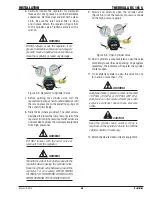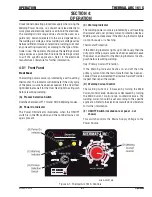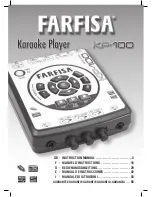
OPERATION
THERMAL ARC 161 S
Manual 0-5073
4-11
4-11
Operation
Operation
4.20 Distortion
Distortion in some degree is present in all forms of
welding. In many cases it is so small that it is barely
perceptible, but in other cases allowance has to be made
before welding commences for the distortion that will
subsequently occur. The study of distortion is so complex
that only a brief outline can be attempted hear.
4.21 The Cause of Distortion
Distortion is cause by:
A. Contraction of Weld Metal:
Molten steel shrinks approximately 11 per cent in volume
on cooling to room temperature. This means that a cube
of molten metal would contract approximately 2.2 per
cent in each of its three dimensions. In a welded joint, the
metal becomes attached to the side of the joint and cannot
contract freely. Therefore, cooling causes the weld metal
to flow plastically, that is, the weld itself has to stretch if
it is to overcome the effect of shrinking volume and still
be attached to the edge of the joint. If the restraint is very
great, as, for example, in a heavy section of plate, the weld
metal may crack. Even in cases where the weld metal does
not crack, there will still remain stresses “locked-up” in
the structure. If the joint material is relatively weak, for ex-
ample, a butt joint in 5/64" (2.0mm) sheet, the contracting
weld metal may cause the sheet to become distorted.
B. Expansion and Contraction of Parent Metal in the
Fusion Zone:
While welding is proceeding, a relatively small volume
of the adjacent plate material is heated to a very high
temperature and attempts to expand in all directions. It
is able to do his freely at right angles to the surface of
the plate (i.e., “through the weld”), but when it attempts
to expand “across the weld” or “along the weld”, it meets
considerable resistance, and to fulfill the desire for con-
tinued expansion, it has to deform plastically, that is, the
metal adjacent to the weld is at a high temperature and
hence rather soft, and, by expanding, pushes against the
cooler, harder metal further away, and tends to bulge (or
is “upset”). When the weld area begins to cool, the “up-
set” metal attempts to contract as much as it expanded,
but, because it has been “upset”, it does not resume its
former shape, and the contraction of the new shape exerts
a strong pull on adjacent metal. Several things can then
happen.
3. Overhead Welds
Apart from the rather awkward position necessary,
overhead welding is not much more difficult that
downhand welding. Set up a specimen for over-
head welding by first tacking a length of angle
iron at right angles to another piece of angle iron
or a length of waste pipe. Then tack this to the
work bench or hold in a vice so that the specimen
is positioned in the overhead position as shown
in the sketch. The electrode is held at 45° to
the horizontal and tilted 10° in the line of travel
(Figure 4-19). The tip of the electrode may be
touched lightly on the metal, which helps to give a
steady run. A weave technique is not advisable for
overhead fillet welds. Use a 1/8" (3.2mm) E6012
electrode at 120 amps, and deposit the first run
by simply drawing the electrode along at a steady
rate. You will notice that the weld deposit is rather
convex, due to the effect of gravity before the
metal freezes.
Art # A-07704
Figure 4-20: Overhead fillet weld














































